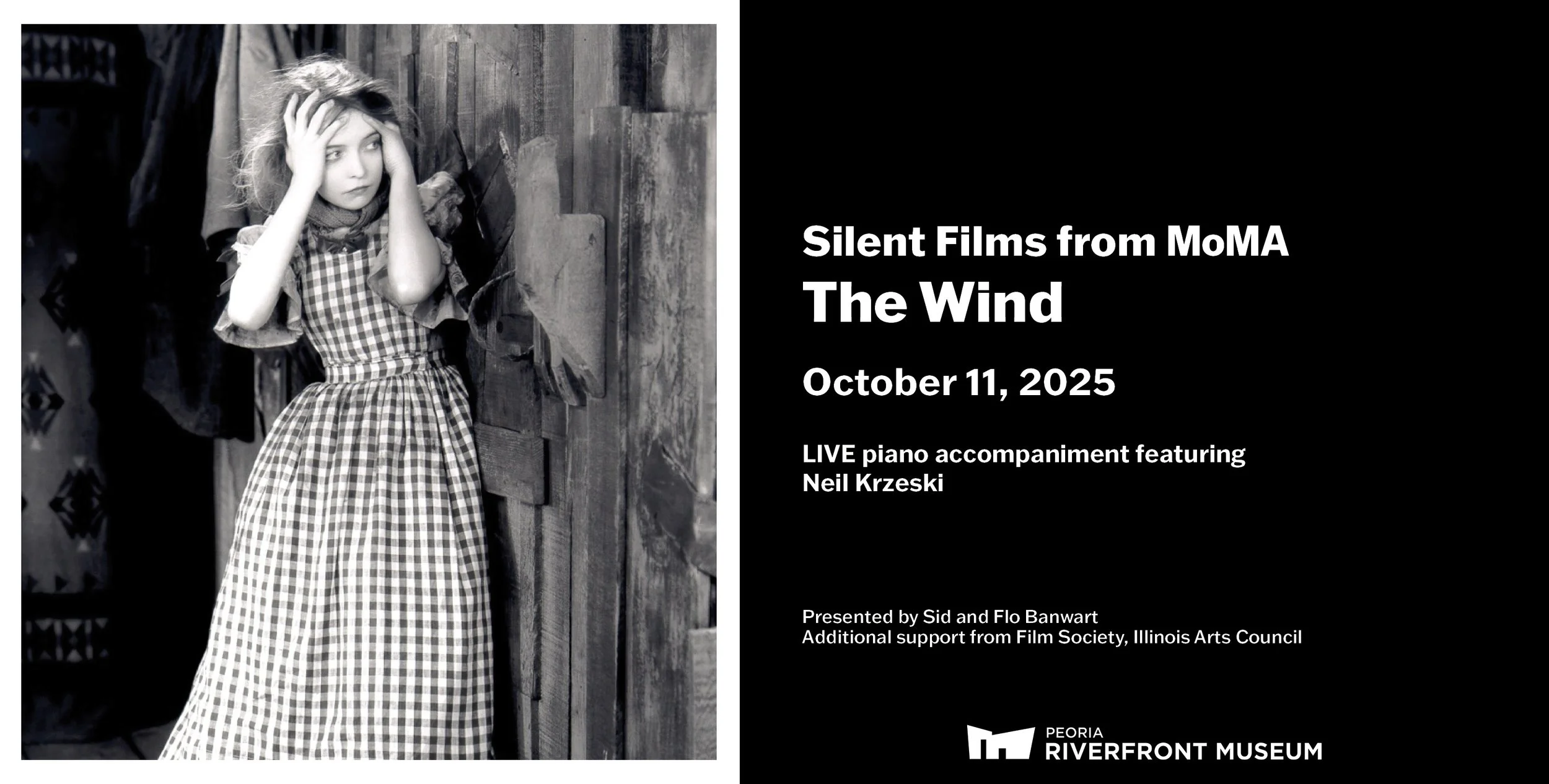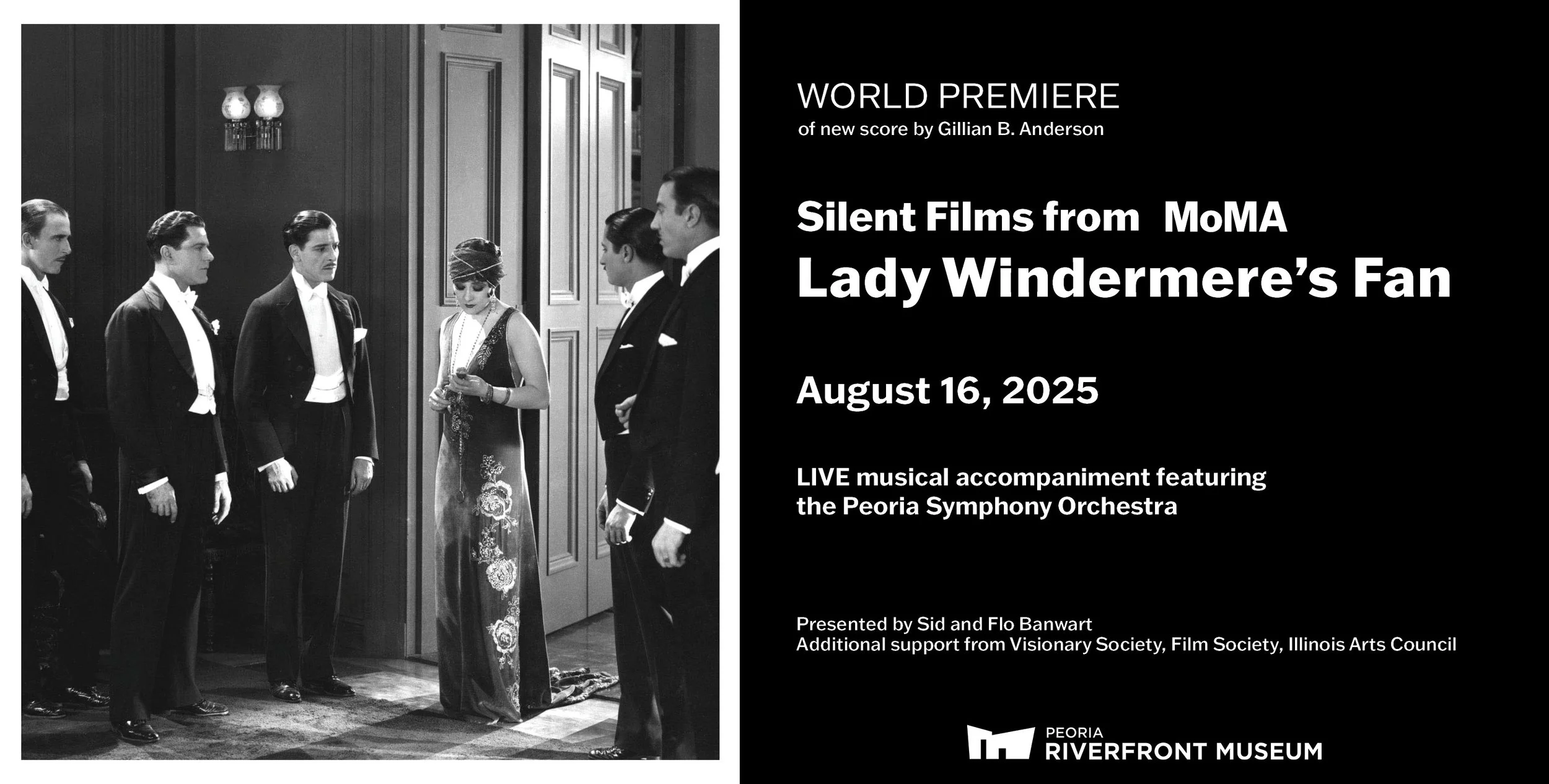
MoMA Silent Film Selection: The Wind (1928)
When Letty Mason (Lillian Gish), an emotionally fragile woman from Virginia, relocates to West Texas, she finds herself unsettled by the ever-present wind and sand. Arriving at her new home at the ranch of her cousin (Edward Earle), she receives a surprisingly cold welcome from his wife (Dorothy Cumming). Soon tensions in the family and unwanted attention from a trio of suitors, including neighbor Lige Hightower (Lars Hanson), leave Letty increasingly disturbed, resulting in tragedy.
LIVE piano accompaniment featuring Neil Krzeski.
Presented by Sid and Flo Banwart. Additional support from Film Society, Illinois Arts Council.

Silent Films from MoMA: Lady Windermere's Fan (1925)
Silent Films from MoMA: Lady Windermere’s Fan (1925)
Saturday, August 16, 2025 | Reception at 5:30 p.m. | Program begins at 6:30 p.m.
Experience the world premiere of a new score by Gillian B. Anderson, performed by the Peoria Symphony Orchestra!
Join us for:
"Silent Films from MoMA: Lady Windermere's Fan"
Saturday, August 16, 2025 | Reception at 5:30 p.m. | Film begins at 6:30 p.m.
See this silent film as never before in this special partnership between the Peoria Riverfront Museum and The Museum of Modern Art, New York, featuring new restorations from MoMA’s renowned collection.
The Peoria Riverfront Museum is proud to present a digitally restored version of Ernst Lubitsch’s 1925 "Lady Windermere’s Fan" with live musical accompaniment featuring the Peoria Symphony Orchestra. This special performance offers an extraordinary evening combining the art of film with a live musical score that elevates the cinema into a truly immersive experience.
Presented by Sid and Flo Banwart
Additional support from Film Society, Illinois Arts Council
Saturday, August 16, 2025
5:30 p.m. - Welcome reception with cocktails and hors d’oeuvres
6:30 p.m. – Performance begins in the Giant Screen Theater
Tickets $50 for members, $65 for non-members
Lady Windermere's Fan. 1925. USA. Directed by Ernst Lubitsch. Screenplay by Julien Josephson, based on the play by Oscar Wilde. With Ronald Colman, May McAvoy, Bert Lytell, Irene Rich. Restored by The Museum of Modern Art, with the financial support of Matthew and Natalie Bernstein. Accompanied by a new score compiled, synchronized, and edited by Gillian B. Anderson, based on a cue sheet issued by the Tax-Free Music Co. compiled by Michael Hoffman for the original release. 94 minutes.
This film program is organized by Dave Kehr, Curator of Film, Sean Egan, Senior Producer, Film Exhibitions and Projects, The Museum of Modern Art, New York.
Live musical accompaniment featuring the Peoria Symphony Orchestra
Presented by Flo and Sid Banwart

The Adventurer (1917)
One truism of film restoration is that the best-loved titles are almost always in the worst shape. Negatives wear out from overuse, old prints are duped to create new ones, and image (and sound) quality are lost with every new analog generation. That’s long been the case with Charles Chaplin’s Mutual shorts, a series of 12 two-reel comedies that Chaplin made in 1916 and 1917. Considered by many to be Chaplin’s funniest, most formally accomplished work, the Mutual shorts have nearly been loved to death after over a century in constant circulation.
MoMA’s new restoration of The Adventurer, the final and, for many, finest of the Mutuals, comes as a revelation. Assembled from seven different sources, almost all from the domestic A negative, often combining elements within a given shot, the MoMA restoration has a clarity and grain structure missing from the film for generations, and has been fitted with remade intertitles that match samples from original prints of other Mutual films. The film now looks—almost eerily—very much as it did when it first appeared on American screens.
The restoration was supervised by Peter Williamson, MoMA’s Film Conservation Manager, and Dave Kehr, Curator, Department of Film, and was carried out at Metropolis Post in New York City. We are especially grateful to Metropolis for their amazing work despite the COVID shutdowns.
Presented by Sid and Flo Banwart
Featuring LIVE piano accompaniment with Dr. Joshua Russell
—
As a special treat, the evening will also feature two classic Charlie Chaplin silent films, The Rink (1916) and The Vagabond (1916), both accompanied by live piano music. Please note that these bonus films are not associated with The Museum of Modern Art.

The Cat and the Canary (1927)
A Broadway hit that helped to launch the theatrical craze for “old dark house” thrillers, John Willard’s 1922 play was already starting to seem old hat by the time Universal acquired it in 1927. But Universal chief Carl Laemmle had the inspiration to send to Germany for Paul Leni, a promising young director who had blended the shadowy lighting and tortured perspectives of German Expressionism with more commercial material for his acclaimed Waxworks (1922). And so was born the look and feel of Universal’s classic horror films. Laura La Plante is the first-generation scream queen, a stylish young woman invited to a decaying mansion for the midnight reading of a will, along with half a dozen other scheming heirs and likely suspects.
Where previous restorations of The Cat and the Canary have been based on the B negative, composed of second-choice takes for release in Europe, this is the first to be based on the A negative used for the US release, and it makes a difference. Panels slide, curtains billow, hands clutch, and mysterious figures roam hidden corridors, all with renewed panache.
Presented by Sid and Flo Banwart
Featuring LIVE piano accompaniment with Dr. Joshua Russell

The Marriage Circle (1924)
With Ernst Lubitsch’s second American film, The Marriage Circle, the director discovered the genre that he would elevate to the heights of formal perfection and emotional resonance: the sophisticated romantic comedy. Working from a forgotten European play (as he so often did), Lubitsch establishes the parallels between two marriages—one beginning to fray (Viennese physician Monte Blue and his neglected wife Florence Vidor) and one in open rupture (professor Adolphe Menjou has hired a private detective to track his unfaithful wife, Marie Prevost, who has set her sights on Blue). Shifting his focus from the grand social canvases of his German films (Madame DuBarry, Carmen) to a handful of characters in drawing rooms brings out Lubitsch’s genius for synecdoche—the art of taking a part to express the whole. When sound came in, Lubitsch (in collaboration with George Cukor) remade The Marriage Circle as the musical One Hour with You in 1931. This new digital restoration of The Marriage Circle is based on a 35mm print in the Museum’s collection.
Presented by Sid and Flo Banwart
Featuring LIVE piano accompaniment with Dr. Joshua Russell

The Navigator (1924)
Directed by Buster Keaton, Donald Crisp. Screenplay by Clyde Bruckman, Joseph A. Mitchell, Jean C. Havez. With Buster Keaton, Kathryn McGuire, Frederick Vroom. 4K digital restoration by The Museum of Modern Art and Lobster Films. Funding provided by The Celeste Bartos Fund for Film Preservation and Lobster Films. Lab work by Lobster Films. 69 min.
To Save and Project presents the world premiere of Buster Keaton and Donald Crisp’s The Navigator (1924) in a new 4K digital restoration by MoMA and Lobster Films. Derived from the world’s oldest and best surviving 35mm print, which curator Iris Barry acquired for MoMA’s collection in the 1940s, and from continuity scripts used to recreate the film’s original tinting, The Navigator will be experienced anew by passionate Keaton devotées and newcomers alike. In a series of surreal, graceful, hilarious—and risky—gags unmatched in the history of cinema, rich and pampered nitwit Buster Keaton finds himself lost at sea with his would-be bride Kathryn McGuire, parrying with feisty swordfish, bloodthirsty cannibals, and the mother of all machine props: a vast deserted ocean liner.
Presented by Sid and Flo Banwart
Featuring LIVE piano accompaniment with Dr. Joshua Russell

Silent Films from MoMA
Silent Films from MoMA: Stella Dallas
Saturday, May 11, 2024 | Reception at 5:30 p.m. | Program begins at 6:30 p.m.
SOLD OUT
Experience silent film as never before in the first-ever partnership between the Peoria Riverfront Museum and The Museum of Modern Art, New York, featuring new restorations from MoMA’s renowned collection.
The Peoria Riverfront Museum is proud to present a digitally restored version of Henry King’s 1925 Stella Dallas with live musical accompaniment featuring the Peoria Symphony Orchestra. This special performance offers an extraordinary evening combining the art of film with a live musical score that elevates the cinema into a truly immersive experience.
Saturday, May 11, 2024
5:30 p.m. - Welcome reception with cocktails and hors d’oeuvres
6:30 p.m. – Performance begins in the Giant Screen Theater
Tickets $75 for members, $100 for non-members
SOLD OUT
Stella Dallas. 1925. USA. Directed by Henry King. Screenplay by Frances Marion, based on the novel by Olive Higgins Prouty. With Ronald Colman, Belle Bennett, Douglas Fairbanks Jr. Digital restoration by the Museum of Modern Art and the Film Foundation, from a 35mm print held by MoMA. Accompanied by a new orchestral score composed by Stephen Horne. 110 min.
This film program is organized by Dave Kehr, Curator of Film, Sean Egan, Senior Producer, Film Exhibitions and Projects, The Museum of Modern Art, New York.
Live musical accompaniment featuring the Peoria Symphony Orchestra
Presented by Flo and Sid Banwart
